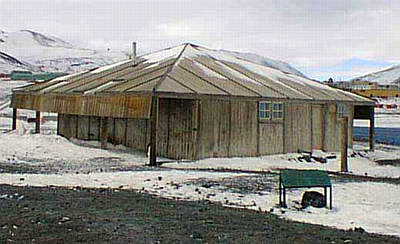
|
|
4 March, 1999
March 4, 1999
Greetings from the Amundsen Sea! Today we continued our transit to the
east. Due to some ice on the night shift and a slight detour on our shift,
our arrival at the next location has been delayed about six hours. We
weren't able to do any seismic, coring, or deep tow today. We continued
taking log every 15 minutes, and the multibeam continued mapping the bottom
of the sea as the ship moved along. That's different from doing a
multibeam survey, however. When we do a multibeam survey, we go back and
forth across an area (like a lawn mower) in order to map a large amount of
the sea floor. Today, we just continued to collect the thin strip of data
from wherever the ship went. Since we didn't have many activities going on
today, it was a day to get some odds and ends finished around the ship. We
did take about an hour to watch a neat movie about the history of
exploration in Antarctica. I can't believe how nice we have it compared to
the people who first sailed down here nearly 180 years ago!
The night shift will begin a seismic line in just a few hours. It is also
expected that they will do a multibeam survey of the area. Tomorrow, we
hope to take a few cores and possibly do a little deep tow side scan sonar.
We'll have to see what the sea floor looks like with the multibeam and
seismic before we make a final decision. After we finish studying this
area, we are heading even further east to Pine Island Bay. Pine Island Bay
is on the Walgreen Coast of the Amundsen Sea. Our question for today was:
"Who was Roald Amundsen?" There are a lot of things named after Mr.
Amundsen here in Antarctica: Mount Amundsen, Amundsen Bay, Amundsen Coast,
Amundsen Glacier, Amundsen Icefall, Amundsen Sea, and Amundsen-Scott South
Pole Station. The last one listed is the one that tells us why Roald
Amundsen was so important . . . he was the first person to reach the South
Pole!
Roald Engebreth Amundsen was born in 1872 in Norway. In his early years,
he dreamed of being the first man to reach the North Pole. He was planning
an expedition to freeze his ship in the ice and drift to the North Pole
when he received the news that American Robert E. Peary had claimed to
reach 90 degrees N (the North Pole) on April 6, 1909. Amundsen quickly and
secretly decided to be the first person to reach the South Pole instead.
He loaded a ship and a crew . . . and left Norway on June 6, 1911. In
fact, Amundsen didn't even tell most of the crew aboard his ship (called
the Fram) where they were heading until they already out to sea!
Amundsen had planned very well for polar weather. He left his base camp on
the Ross Ice Shelf and set out for the South Pole on October 19, 1911. He
had four other men with him. Between them, there were four sledges to
carry their gear and each sledge was pulled by 13 Greenland dogs. The men
also were trained well in the use of skis, and this helped them out a lot.
Amundsen also took extra food and supplies that he left in depots along the
way. They arrived at the South Pole on December 14, 1911, and camped there
for three days before following their same route home. They arrived back
where they started, near Roosevelt Island on the Ross Ice Shelf, on January
25, 1912.
Captain Robert Falcon Scott was a British explorer who was born in 1868. He
spent time in Antarctica during the years 1902-1904, and he made many
discoveries. During his "Discovery" Expedition, Scott also attempted to
reach the South Pole. There were three men, along with sledges and dogs,
who headed for the South Pole on November 2, 1902. Although a large depot
of food was laid out by an advance party, none of the men had tried skiing
or sled dog-driving, and they were only able to reach as far south as 82
degrees, 16.5 minutes, before turning back.
When Amundsen told his men exactly where they were and what they were
doing, he also sent a telegram to Scott. In this telegram, Amundsen said,
"Beg leave to inform you Fram proceeding Antarctic Amundsen." Scott was
very upset that Amundsen might beat him to the pole, so he quickly sailed
from New Zealand to Antarctica -- arriving at Ross Island in January, 1911,
to begin what was called the "Terra Nova" expedition. Scott began his trip
to the pole on October 24, 1911. He had men and ponies go ahead and set up
depots of food and supplies. On January 4, 1912, the final support party
turned back, and Scott marched on toward the South Pole along with four
other men. All five men arrived at the South Pole on January 17, 1912 --
only to find out that Amundsen had beaten them by 33 days.
The return trip home for Scott and his men was rough. They had a hard time
finding their depots, they were hungry, and they were cold. One of the men
died February 17, 1912. Another walked into a blizzard to his death about
a month later. Scott and his final two men became stuck in a blizzard on
March 21st. They were not able to leave their tent because of the weather.
Scott kept a diary throughout this adventure, and the last entry was dated
March 29, 1912. All of the men died -- and they were only about 11 miles
from one of their depots.
Although the men didn't survive, they did accomplish many important things
on their expedition. Scott and his men dragged about 35 pounds of
geological samples back with them, which were found and later analyzed; and
his diary remains an important historic document. In addition, there were
several other parties under his direction that made new discoveries in
Antarctica. Three of his men became the first people to collect Emperor
penguin eggs by traveling for five weeks in the dark, Antarctic winter.
During this time, temperatures dropped down to eighty degrees below zero
Fahrenheit!
Well, that's about all for today. I've had some requests for a journal
about other types of Antarctic wildlife (besides penguins, seals, and
whales). What other types of animals do you think exist in Antarctica?
That will be our topic for tomorrow. If you have any suggestions for
journal topics, don't hesitate to send them to me. I also love getting all
of your email questions . . . keep it up!
Kim Giesting
Latitude: 73 degrees 11 minutes South
Longitude: 113 degrees 59 minutes West
Temperature: -5.0 degrees C
Barometer: 982.3
Wind Speed: 28.9 knots
Wind Direction: 138 degrees (from the Southeast)
Sunrise: 03:22
Sunset: 16:20

This is a picture of Scott's hut from the 1902 "Discovery" expedition. This hut is located next to the pier at McMurdo Station.

These original supplies can still be seen inside Scott's hut.
Contact the TEA in the field at
.
If you cannot connect through your browser, copy the
TEA's e-mail address in the "To:" line of
your favorite e-mail package.
|
